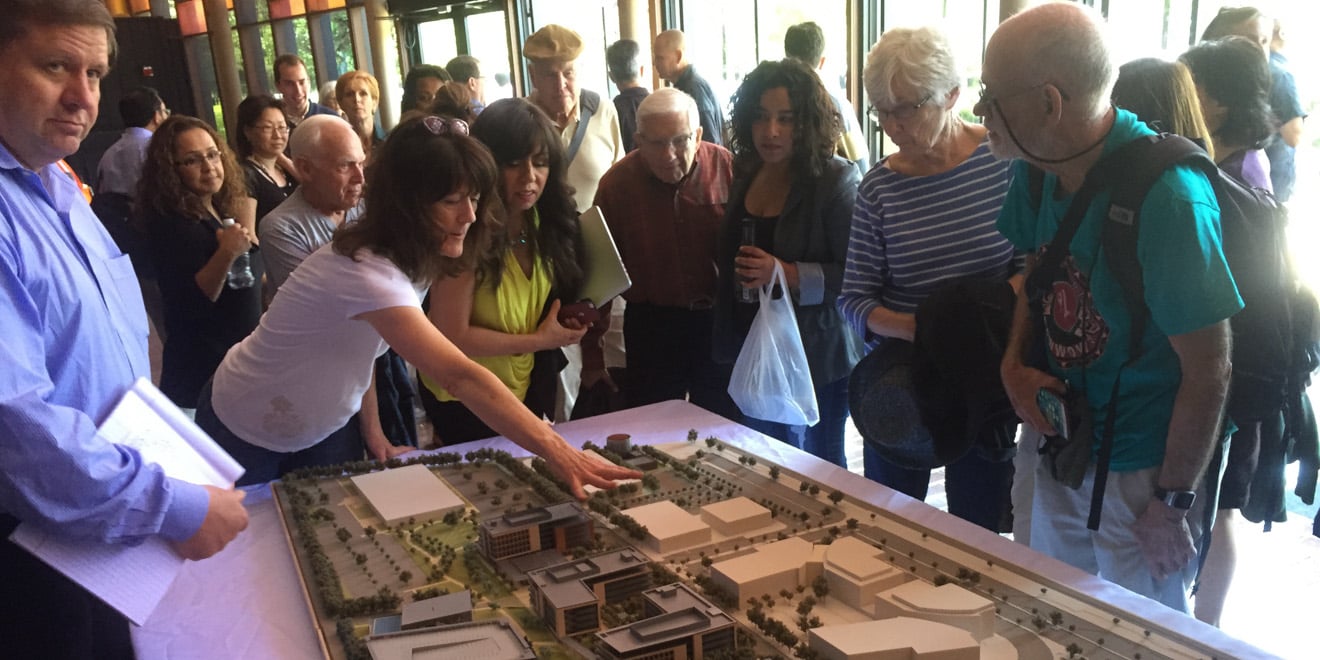At a Tuesday town hall, Provost John Etchemendy Ph.D. ’82 and other key planners discussed Stanford’s Redwood City campus, which is expected to accommodate 2,400 University employees when it opens in 2019.
Stanford in Redwood City marks the University’s first major expansion beyond its Palo Alto home. It will also be the University’s largest construction project to date, costing roughly $570 million to build. While the project’s design team is already working with an advisory committee representing the eight departments that will be at least partially relocating, the town hall in Dinkelspiel Auditorium gave community members their first more detailed look at the new campus, as well as a forum to voice their input.
Through a presentation and Q&A session that were also webcast, Etchemendy and project leaders introduced the new campus as an “exciting” development with top-notch facilities, but met some concerns from attendees about the repercussions of the new campus for both employees and students.
Stanford’s vision
Etchemendy said that the Redwood City campus is necessary for the growth of the University, whose expansion in Palo Alto is constrained by its General Use Permit and by worry from the surrounding community that expansion would badly impact traffic. As Stanford continues to add faculty as well as staff to support them, its campus is no longer big enough for its academic ambitions, Etchemendy said.
“As advances are made in different fields, new avenues open up and … we have to add faculty who specialize in those areas,” he said, adding later, “If we don’t expand, we will no longer be a great university.”
To make room, Stanford is developing over 1.5 million square feet in Redwood City. In deciding which employees to relocate, University planners chose departments whose work does not require daily contact with students. They also looked for departments that are currently scattered around the main campus and could benefit from a more concentrated location.
The new campus will house employees from Business Affairs, Land, Buildings and Real Estate (LBRE), the Office of Development, Residential and Dining Enterprises (R&DE), the School of Medicine, the Graduate School of Business (GSB) and Libraries and University Human Resources (UHR). Three department vice provosts will also be relocating, and the Continuing Studies program for adult students is considering moving some or all of their classes to Redwood City.
Subcommittees on the advisory committee drawn from these departments have been investigating issues such as transportation and communication between Redwood City and Palo Alto.
“The campus is being designed from the ground up with the people who will be using it,” Etchemendy said.
David Lenox, University architect and executive director of campus planning and design, laid out Stanford’s architectural vision. The space will include a “high-energy” central destination that Lenox called a “town square,” a “greenway” running down the campus center and amenities such as fitness center and a childcare facility.
Lenox said that the architecture, while more modern-looking, will strive for continuity with the main campus, incorporating Stanford signatures like the terra cotta material used in the University’s tiled roofs.
Community concerns
Transportation emerged as a key concern for employees at the town hall, with a chorus of staff wondering if their commute was about to become more difficult.
Stanford is building a parking garage for the Redwood City campus. It will also run a shuttle between campus and the nearby Caltrain station, timed to meet all trains throughout the day. However, one employee from the South Bay still wondered what their options would be now that she cannot cannot take the Valley Transportation Authority (VTA) to work. Another employee wanted to know how late train shuttles would run, a detail that Stanford is still working out.
“I live in Mountain View and I have no intention of driving to this campus,” the employee said. “I don’t work standard hours, and right now, the shuttle service and the trains do not work well for me at all. You’ve got to do better than that.”
While the vast majority of the town hall’s audience were Stanford employees, a few students attended. One, a senior, expressed concern during the Q&A that students had been given little opportunity for input on the Redwood City expansion. He noted that even though the campus was intended for staff, the changes could also affect students by making University officials less accessible.
“It’s already difficult for students to meet with administrators,” he said, going on to cite R&DE as one department whose higher-up employees could potentially benefit from more interaction with students. He urged planners to consider a direct bus line from Palo Alto to the Redwood City campus, given that many students do not have cars and might find it inconvenient to use Caltrain.
“Students are asking for more transparency right now from the administration, not less,” he said.
“This is not Siberia,” Etchemendy responded. “This is five miles away, available by electronic communication. I don’t think that that is going to be a problem.”
Still, Etchemendy and Lenox admitted that creating convenient audiovisual communication between campuses would take planning.
“It can’t just be everyone in Redwood City learning how to do remote communication,” Lenox said. “How are we going to create places on our main campus where people can come together?”
Contact Hannah Knowles at hknowles ‘at’ stanford.edu.
